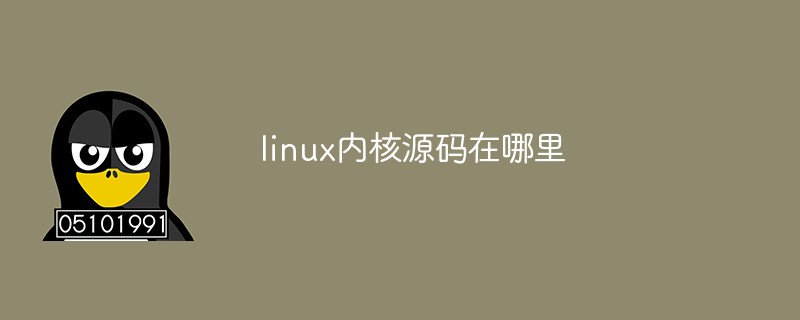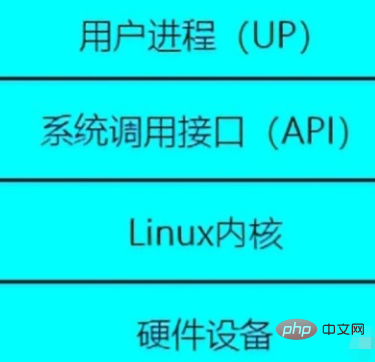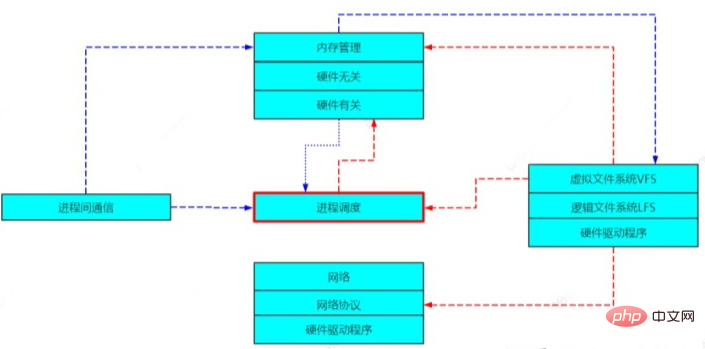 Operation and Maintenance
Operation and Maintenance
 Linux Operation and Maintenance
Linux Operation and Maintenance
 Where is the linux kernel source code?
Where is the linux kernel source code?
Where is the linux kernel source code?
The location of the Linux kernel source code is generally in the "/usr/src/linux kernel version" directory in the system; if there is no similar directory in the system, it is because the kernel code has not been installed yet. The kernel is the entire operating system. The soul is responsible for managing disk files, memory, starting and running programs, receiving and sending data packets from the network, etc.

#The operating environment of this tutorial: linux7.3 system, Dell G3 computer.
Where is the linux kernel source code
Generally in /usr/src/linux*.*.* in the Linux system (*.*.* represents the kernel version, such as 2.4.23) The directory is the kernel source code (if there is no similar directory, it is because the kernel code has not been installed yet). It can also be downloaded for free from the Internet.
Expand knowledge
The role and abstract structure of the kernel
The position of the Linux kernel in the entire operating system, the Linux kernel The location in the entire operating system is as shown in the figure below:

The Linux operating system consists of four parts (four layers of dependencies-->The upper layer depends on the lower layer):
User process: User application is a collection of software running at the highest level of the Linux operating system.
System call interface: System call runs in the kernel state, or system state, and generally runs in the user state. System calls are part of the kernel code.
Linux kernel: The kernel is the soul of the entire operating system. It is responsible for managing disk files, memory, starting and running programs, receiving and sending data packets from the network, and so on.
Hardware equipment: Linux installation requires all possible physical equipment, such as: CPU, hard disk, network hardware, etc.
The role of the Linux kernel
From the perspective of a software engineer, the operating system kernel provides an extended or virtual computing platform that is equivalent to computer hardware. Ordinary users think of the operating system as a resource manager. Linux supports multitasking in a unified manner, and this method is transparent to user processes. Each process runs as if it is the only process running on the computer, monopolizing memory and other hardware resources.
Linux kernel abstract structure. It is composed of 5 main subsystems. The specific architecture is shown in the following figure:

-
a. Process scheduling controls the process’s access to the CPU
b. Memory management allows multiple processes to safely share the main memory area.
c. The virtual file system VFS hides the specific details of different hardware devices and provides a unified interface for all devices.
d. The network interface provides access to various network standard protocols and support for various network hardware.
e. Inter-process communication IPC supports various communication mechanisms between processes.
Recommended learning: Linux video tutorial
The above is the detailed content of Where is the linux kernel source code?. For more information, please follow other related articles on the PHP Chinese website!

Hot AI Tools

Undresser.AI Undress
AI-powered app for creating realistic nude photos

AI Clothes Remover
Online AI tool for removing clothes from photos.

Undress AI Tool
Undress images for free

Clothoff.io
AI clothes remover

AI Hentai Generator
Generate AI Hentai for free.

Hot Article

Hot Tools

Notepad++7.3.1
Easy-to-use and free code editor

SublimeText3 Chinese version
Chinese version, very easy to use

Zend Studio 13.0.1
Powerful PHP integrated development environment

Dreamweaver CS6
Visual web development tools

SublimeText3 Mac version
God-level code editing software (SublimeText3)

Hot Topics
 1378
1378
 52
52
 How to start nginx in Linux
Apr 14, 2025 pm 12:51 PM
How to start nginx in Linux
Apr 14, 2025 pm 12:51 PM
Steps to start Nginx in Linux: Check whether Nginx is installed. Use systemctl start nginx to start the Nginx service. Use systemctl enable nginx to enable automatic startup of Nginx at system startup. Use systemctl status nginx to verify that the startup is successful. Visit http://localhost in a web browser to view the default welcome page.
 How to check whether nginx is started
Apr 14, 2025 pm 01:03 PM
How to check whether nginx is started
Apr 14, 2025 pm 01:03 PM
How to confirm whether Nginx is started: 1. Use the command line: systemctl status nginx (Linux/Unix), netstat -ano | findstr 80 (Windows); 2. Check whether port 80 is open; 3. Check the Nginx startup message in the system log; 4. Use third-party tools, such as Nagios, Zabbix, and Icinga.
 How to start nginx server
Apr 14, 2025 pm 12:27 PM
How to start nginx server
Apr 14, 2025 pm 12:27 PM
Starting an Nginx server requires different steps according to different operating systems: Linux/Unix system: Install the Nginx package (for example, using apt-get or yum). Use systemctl to start an Nginx service (for example, sudo systemctl start nginx). Windows system: Download and install Windows binary files. Start Nginx using the nginx.exe executable (for example, nginx.exe -c conf\nginx.conf). No matter which operating system you use, you can access the server IP
 How to solve nginx304 error
Apr 14, 2025 pm 12:45 PM
How to solve nginx304 error
Apr 14, 2025 pm 12:45 PM
Answer to the question: 304 Not Modified error indicates that the browser has cached the latest resource version of the client request. Solution: 1. Clear the browser cache; 2. Disable the browser cache; 3. Configure Nginx to allow client cache; 4. Check file permissions; 5. Check file hash; 6. Disable CDN or reverse proxy cache; 7. Restart Nginx.
 How to solve nginx403 error
Apr 14, 2025 pm 12:54 PM
How to solve nginx403 error
Apr 14, 2025 pm 12:54 PM
The server does not have permission to access the requested resource, resulting in a nginx 403 error. Solutions include: Check file permissions. Check the .htaccess configuration. Check nginx configuration. Configure SELinux permissions. Check the firewall rules. Troubleshoot other causes such as browser problems, server failures, or other possible errors.
 How to check whether nginx is started?
Apr 14, 2025 pm 12:48 PM
How to check whether nginx is started?
Apr 14, 2025 pm 12:48 PM
In Linux, use the following command to check whether Nginx is started: systemctl status nginx judges based on the command output: If "Active: active (running)" is displayed, Nginx is started. If "Active: inactive (dead)" is displayed, Nginx is stopped.
 How to clean nginx error log
Apr 14, 2025 pm 12:21 PM
How to clean nginx error log
Apr 14, 2025 pm 12:21 PM
The error log is located in /var/log/nginx (Linux) or /usr/local/var/log/nginx (macOS). Use the command line to clean up the steps: 1. Back up the original log; 2. Create an empty file as a new log; 3. Restart the Nginx service. Automatic cleaning can also be used with third-party tools such as logrotate or configured.
 Difference between centos and ubuntu
Apr 14, 2025 pm 09:09 PM
Difference between centos and ubuntu
Apr 14, 2025 pm 09:09 PM
The key differences between CentOS and Ubuntu are: origin (CentOS originates from Red Hat, for enterprises; Ubuntu originates from Debian, for individuals), package management (CentOS uses yum, focusing on stability; Ubuntu uses apt, for high update frequency), support cycle (CentOS provides 10 years of support, Ubuntu provides 5 years of LTS support), community support (CentOS focuses on stability, Ubuntu provides a wide range of tutorials and documents), uses (CentOS is biased towards servers, Ubuntu is suitable for servers and desktops), other differences include installation simplicity (CentOS is thin)



